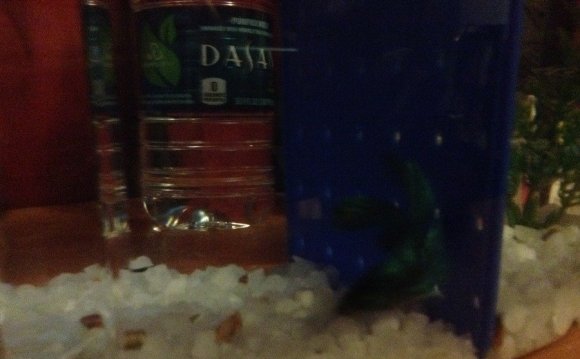
 Courtesy of Joel Carnat
Courtesy of Joel Carnat
Hello! This is just a simple blog post about betta fish care. Hope you like it!
Housing:
This what your betta tank should have:
1. The tank should be no less then 5 gallons for a single betta, if you want tankmates, then a 10 gallon is better.
2. Live or silk plants, fake plastic plants can tear a bettas long fins.
3. An appropriate filter, on the lowest flow setting, or the intake tube covered with a piece of aquarium sponge, panty hose, or similar, or with a sturdy plant or decoration at the front to decrease the flow.
4. A appropriate heater, set on 78 degrees is good.
5. A thermometer to check the exact temperature.
6. A tank lid. In rare cases, a betta can jump out of its tank. Even if I said rare, it could happen. You don’t want to come home to see your beloved betta on the floor.
Things you need:
1. A liquid test kit like the API Freshwater Master Test Kit, this is so you can test the water for toxins. Strips are not accurate.
2. A gravel vacuum, to vacuum the gravel or the substrate you have.
3. 2 buckets, one for removing water tank, one for putting clean water in. Make sure that the buckets have not been used for anything.
4. Water Conditioner. This is a must, it removes the chlorine, chloramine, and heavy metals that can harm your fish from tap water. Prime is a great water conditioner, it keeps toxins at bay for 48 hours, and you only need a few drops. Stress Coat and Amquel plus are good water conditioners too.
5. Betta food. Flakes are not that good. Buy food made for bettas, as they require a special diet. New Life Spectrum carries a good betta pellet food, and once in a while, feed your betta live or frozen foods as a treat. Freeze dried food expand in a fishes stomach, causing bloat. They should be soaked in a small cup of aquarium water before feeding. Brine shrimp and bloodworms are good live foods to feed.
A betta isn’t that hard to care for, but that doesn’t mean that you should neglect it.
Here are some tips on how to care for a betta:
Do weekly 25% water changes, and vacuum the substrate.
Make sure that the new water you put in is the same temperature, and is treated with the correct amount of water conditioner.
Don’t replace the filter cartridge. I know, how is that taking care of a fish? Well, if you replace it, then all the good bacteria that was in there is going to be removed, and there will not be any good bacteria to turn the ammonia into nitrites then nitrates. And at the end, your fish could get ammonia poisoning. You can swish it in some old tank water when you do a water change, though.
Feed him as much as he can eat in a minute, and remove any leftover food. Don’t overfeed, as that can lead to ammonia.
If there are any dead or decaying leaves from the live plants, remove them.
Check the water weekly, there should be zero ammonia, zero nitrite, and 5-20 ppm nitrate. If any of these are high, do a immediate 25% water change, maybe more if the level is very high, and continue until it reaches normal.
Check daily to see if everything is normal about your betta.
Here is a short list of problems and the symptoms and also the treatments.
Use medicine at a last resort, as they are harsh and can make it worse.
Tiny white spots on the body of the fish, look like grains of salt: Ich/ick
Treatment: A salt bath, with aquarium salt, fallow the package directions. Usually its a teaspoon for every gallon or a tablespoon for every 5 gallons. Don’t use table salt, it has additives and anti-caking agents that can harm fish. Raising the temperature slowly to about 80-83 degrees will speed up the life cycle of the parasite, but make sure the change is done SLOWLY. Also do small daily water changes.
Red gills/Black patches on body/looks like red blood under the gills: Ammonia poisoning
Treatment: Immediately test the water for ammonia, and if it actually is high, quickly do a 25-50% water change. depending on how high it is. Don’t remove to much water, if it is really high, do water changes every few hours, this reduces the stress on the fish then removing a big amount of water.
Having trouble swimming/can’t stay up/swimming in circles: Swim Bladder Disorder
There is this organ called a swim bladder in ever fish and it helps it swim, and some times if overfed or if the nitrates are high, it can make the fish swim funny.
Treatment: First, check the nitrates. If they are high, do a water change. After the nitrates are under control, fast the fish for a few days, and only feed him peas. You first take a pea, then put it in the microwave with enough water to cover it for about 5-10 seconds to soften it, remove the skin, let it cool, then just drop a small amount in the tank so the fish can eat it.
Torn fins/Missing fin pieces: Fin rot
First, check that there are no fin nipping fish and that the fish couldn’t have torn its fins on a decoration or plant. If your positive that it is a disease, then do the treatment.
Treatment: A salt bath with aquarium salt can help. The fins will heal by themselves, just take good care. Good water conditions, correct temperature, and clean water all can help.









